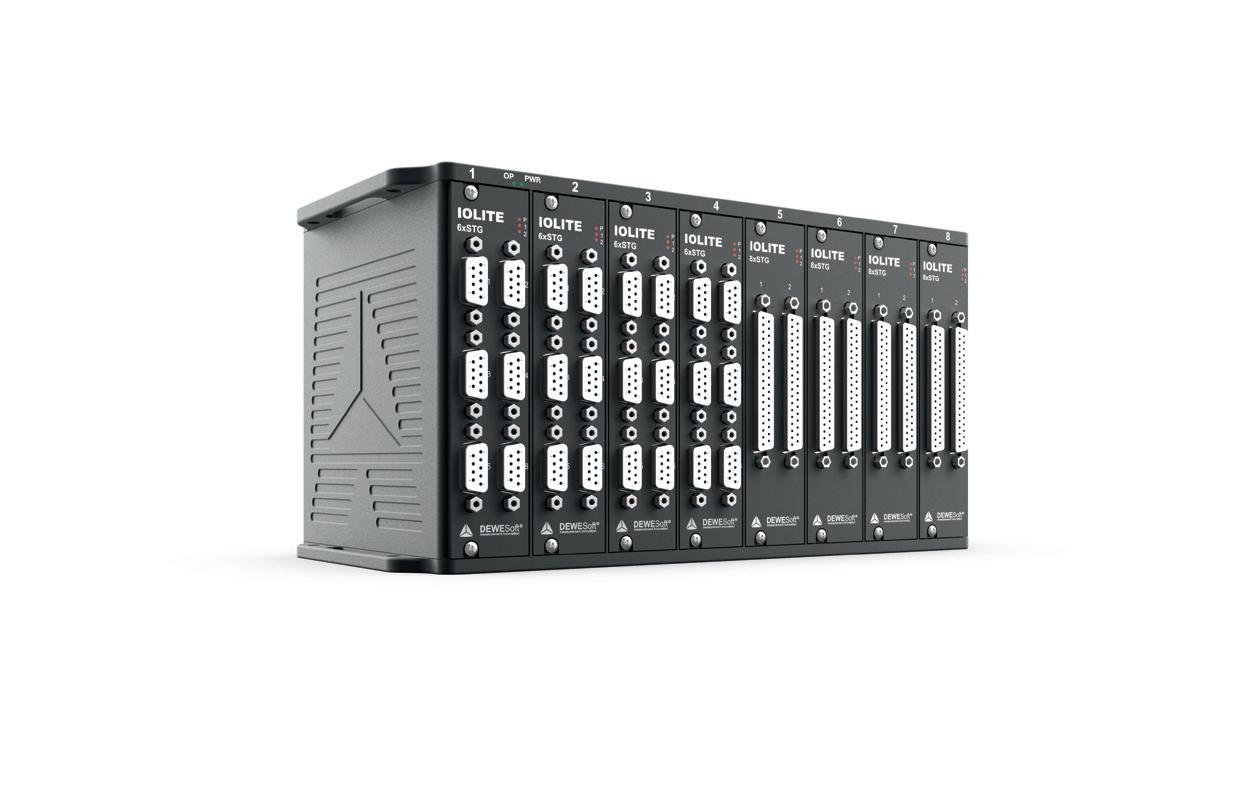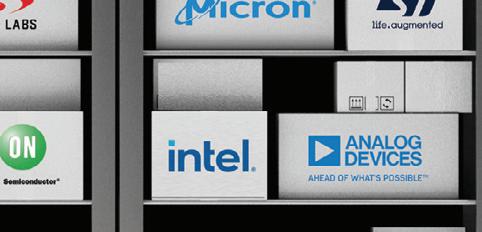
12 minute read
World’s fastest’ optical neuromorphic processor revealed
OPTICAL NEUROMORPHIC PROCESSOR REVEALED
An international team of researchers have demonstrated what they claim is the world’s fastest and most powerful optical neuromorphic processor for artificial intelligence (AI), which operates faster than 10 trillion operations per second (TeraOPs/s) and is capable of processing ultralarge-scale data. Published in the journal Nature, the team’s breakthrough is said to represent a leap forward for neural networks and neuromorphic processing in general.
Artificial neural networks, a key form of AI, can ‘learn’ and perform complex operations with wide applications to computer vision, natural language processing, facial recognition, speech translation, playing strategy games, medical diagnosis and many other areas. Inspired by the biological structure of the brain’s visual cortex system, artificial neural networks extract key features of raw data to predict properties and behaviour with unprecedented accuracy and simplicity.
Led by Melbourne’s Swinburne University of Technology, the international research team achieved an exceptional feat in optical neural networks: dramatically accelerating their computing speed and processing power. They demonstrated an optical neuromorphic processor operating more than 1000 times faster than any previous processor, with the system also processing record-sized ultralargescale images — enough to achieve full facial image recognition, which other optical processors have been unable to accomplish.
“This breakthrough was achieved with ‘optical micro-combs’, as was our world-record internet data speed reported in May 2020,” said Professor David Moss, Director of Swinburne’s Optical Sciences Centre and co-leader of the research.
While state-of-the-art electronic processors such as the Google TPU can operate beyond 100 TeraOPs/s, this is done with tens of thousands of parallel processors. In contrast, the optical system demonstrated by the team uses a single processor and was achieved using a new technique of simultaneously interleaving the data in time, wavelength and spatial dimensions through an integrated micro-comb source. Micro-combs are relatively new devices that act like a rainbow made up of hundreds of high-quality infrared lasers on a single chip, and are said to be much faster, smaller, lighter and cheaper than any other optical source.
“In the 10 years since I co-invented them, integrated microcomb chips have become enormously important and it is truly exciting to see them enabling these huge advances in information communication and processing,” Prof Moss said. “Microcombs offer enormous promise for us to meet the world’s insatiable need for information.”
“This processor can serve as a universal ultrahigh-bandwidth front end for any neuromorphic hardware — optical or electronic based — bringing massive-data machine learning for real-time ultrahighbandwidth data within reach,” added co-lead author Dr Xingyuan (Mike) Xu, Swinburne alum and postdoctoral fellow at Monash University.
“We’re currently getting a sneak peek of how the processors of the future will look. It’s really showing us how dramatically we can scale the power of our processors through the innovative use of microcombs.”
Distinguished Professor Arnan Mitchell, study co-leader from RMIT University, added, “This technology is applicable to all forms of processing and communications — it will have a huge impact. Long term we hope to realise fully integrated systems on a chip, greatly reducing cost and energy consumption.”
Professor Damien Hicks, from Swinburne and the Walter and Eliza Hall Institute, is a key supporter of the research team. He said, “Convolutional neural networks have been central to the artificial intelligence revolution, but existing silicon technology increasingly presents a bottleneck in processing speed and energy efficiency.
“This breakthrough shows how a new optical technology makes such networks faster and more efficient and is a profound demonstration of the benefits of cross-disciplinary thinking, in having the inspiration and courage to take an idea from one field and using it to solve a fundamental problem in another.”

Dr Xingyuan (Mike) Xu with the integrated optical microcomb chip, which forms the core part of the optical neuromorphic processor.



EMBEDDED DATA ACQUISITION SYSTEM
Dewesoft’s IOLITE LX embedded data acquisition system is based on a dual-core, 1.5 GHz ARM processor, which runs Dewesoft RT data acquisition software on a Linux OS. This combination gives the system the flexibility to act as a standalone data logger, a real-time control system, or a signal conditioning system with cloud or Industry 4.0 connectivity.
The product is powerful but designed to operate with low power consumption, making it suitable for any measurement application. It offers the same high-end signal conditioning modules as the IOLITE DAQ and control system; amplifiers are available for IEPE, voltage, current, resistance, strain gauge, bridge, digital counters, RTDs and thermocouples. It offers 32 GB of internal storage, expandable with an SD card of up to 1 TB.
Instead of being used internally by Dewesoft RT, the primary EtherCAT bus can be switched to external mode, allowing IOLITE LX to be used like a regular IOLITE system for full-speed buffered data acquisition to a computer running DewesoftX DAQ software. A secondary EtherCAT bus can be used in parallel to serve real-time data to any third-party control system. Standard data interfaces are available to transfer the data to real-time controllers, cloud servers and Industry 4.0 clients, using standard data interfaces such as EtherCAT, OPC UA, XCP and CAN.
The system includes DewesoftX data acquisition software, which is easy to use yet rich in functionality. It is also equipped with a redundant power supply. If the primary power supply fails, the system will be powered by a secondary power supply without any interruption or system shutdown/restart. Metromatics Pty Ltd www.metromatics.com.au


REWIREABLE IEC CONNECTORS
SCHURTER expands its portfolio of rewireable IEC cord connectors, the series 4782 (C13, 70°C) and 4781 (C15, 120°C), to include grey and white versions in addition to black. The added colours allow distinction between multiphases, especially in data centres, and the colour white is also a preferred option for medical applications as far as aesthetics is concerned.
The detachable cord connectors are particularly suited to small series builds with varying cable lengths and country-specific plugs that would otherwise require a large minimum order. The protective cable guard with a diameter of 8.5 mm or 10 mm is pre-assembled at the factory, and the screw terminals accept cables with cross-sections between a minimum of 3 x 0.75 mm2/18 AWG (0.82 mm2) and a maximum of 3 x 1.5 mm2/14 AWG (2.08 mm2).
The 4782 and 4781 series are compliant to the UL 60320 standard, and are also approved by safety agencies for the European, Chinese, Japanese and North American markets. No halogens are used in the cable guard or any of the other plastic components. SCHURTER (S) PTE LTD www.schurter.com
RF FRONT-END IC FOR GNSS RECEIVERS
STMicroelectronics’ BPF8089-01SC6 RF front-end IC for global navigation satellite system (GNSS) receivers simplifies design and saves real estate by integrating the impedance-matching and electrostatic-discharge (ESD) protection circuitry typically implemented using discrete components.
The product provides a 50Ω matched interface between the receiver’s antenna and low-noise amplifier (LNA), and is ready to plug and play with ST’s STA8089 and STA8090 LNAs. The compact, integrated device typically replaces a matching network containing up to five capacitors, resistors and inductors, as well as two discrete protection devices, resulting in a small footprint. Designers can also leverage PCB-track specifications provided in the device datasheet to ease design challenges and ensure optimal performance. The ESD protection provided complies with IEC 61000-4-2 and exceeds level 4: 8 kV for contact discharge and 15 kV for air discharge. The device also withstands 2 kV pulse voltage in accordance with MIL STD 883C. The product is suitable for use in portable satellite receivers for GPS, Galileo, GLONASS, BeiDou and QZSS constellations, which may be used in a number of applications including consumer satellite navigation, radio base stations, drones and tracking of assets or livestock. It is housed in a SOT23-6L package that is compatible with automatic optical inspection. STMicroelectronics Pty Ltd www.st.com













































64-BIT MPUs
Renesas has expanded its RZ/G2 general-purpose 64-bit microprocessor (MPU) series, delivering improved AI processing for a wide range of applications. The expanded product line-up includes three entry-level MPU models built around the latest Arm Cortex-A55 core: the RZ/G2L, RZ/G2LC and RZ/G2UL. Together with the existing mid- to high-end RZ/G2E, RZ/G2N, RZ/G2M and RZ/G2H MPUs, the series provides scalability from entry-level to high-end design.
The latest MPUs are built around the Cortex-A55 CPU core, which is said to deliver approximately 20% improved processing performance compared with the previous Cortex-A53 core and to provide approximately six times faster essential processing for AI applications. In addition, the MPUs integrate camera input interfaces, a 3D graphics engine and a video codec, providing support for sophisticated functionality for human-machine interface (HMI) applications, such as multimedia processing, GUI rendering and AI image processing. The MPUs also feature the Cortex-M33 core, which makes it possible to perform real-time processing for tasks such as sensor data collection without the need for external microcontrollers (MCUs).
The entry-level MPUs feature error checking and correction (ECC) protection for both on-chip memory and external DDR memory. Support for security functions means that users can confidently adopt the MPUs for industrial applications requiring extended service life, making it possible to bring their products to market quickly. For cases where more sophisticated AI functionality may be required, Renesas plans to enhance the functions and performance of the MPUs with its AI accelerator, the DRP-AI. Renesas Electronics www.renesas.com

INLINE MEASUREMENT AND CONTROL SYSTEM
As the production of lithium-ion batteries continues to increase, driven by the growth in demand for electric vehicles and renewable energy storage, lithium-ion battery manufacturers are seeking to scale up operations while maintaining quality, uniformity, traceability and safety in their battery products. The Thermo Scientific LInspector inline measurement and control system addresses that demand and is specifically designed to detect defects in lithium-ion battery electrode coatings, electrode calendering and separator films during the manufacturing process while reducing waste and improving battery quality.
The measurement and control system is said to offer a combination of improved basis weight determination; increased scan coverage; measurement precision; and novel remote instrument health and status monitoring capabilities. These developments enable good coating and thickness control, allowing manufacturers to confidently deliver quality lithium-ion battery products at scale. The system also includes innovative diagnostic display screens and data reporting purpose-built for battery factory environments.
The product enables battery manufacturers to consistently qualify the thickness and coating uniformity of battery electrodes during the production process. The system has intelligent instrument performance monitoring (IPM) with secure data archival and full traceability of product defects. These innovations should enable battery manufacturers to improve their product quality and prevent defective batteries from reaching cars, clean energy storage systems and consumer electronics. Thermo Fisher Scientific thermofisher.com
PCB CONNECTOR SYSTEM
HARTING’s har-modular is a connector system for PCBs. It is a modular concept based on DIN 41612 connectors, but modularly configurable as from batch size 1. Modularity is thereby redefined for design-in devices. With an online configurator, it is possible to select from a trillion possible combinations and thereby always arrive at the optimal solution, even for small series and prototypes. This represents a simplification of work and time savings on the way to the finished product. Users can choose from any number of contacts for power, signals and data. Where several connectors used to be necessary, the system combines all the desired lifelines signal, data and power in one single connection. HARTING Pty Ltd www.harting.com.au









